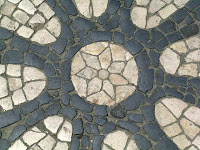We headed off for the theater, the bus hurtling through the heavy smog and congested streets, snapping photos of daily life through the windows all along the way.
Soon we passed by Beijing's tallest building, the World Trade Center.
The CCTV Building, The national television broadcasting networks.
Finally we reached the Theater.
The CCTV Building, The national television broadcasting networks.
Finally we reached the Theater.
We jumped off the bus and sauntered up to the theater entrance.
Granny arrives at the theater.
We were seated in the VIP section.
Before the show started many of the cast circulated through the audience in their costumes.
 Acrobatics is an ancient art in China with its beginnings going way back 4,000 years to the Xia Dynasty. Its popularity exploded about 2,500 years ago during the Warring States Period (475 BC – 221 BC) with the growing interest and support of the China’s emperors.
Acrobatics is an ancient art in China with its beginnings going way back 4,000 years to the Xia Dynasty. Its popularity exploded about 2,500 years ago during the Warring States Period (475 BC – 221 BC) with the growing interest and support of the China’s emperors.
It grew out of the people’s everyday lives and used instruments of labor and common articles of daily use. The performances used such items and tridents, wicker rings, tables, chairs, jars, plates, and bowls. Traditional group gymnastics and the Lion Dance came from folk sports and games.
By the Han Dynasty (221 BC – 220 AD), acrobatic acts had become the “Hundred Plays” with further development of the content and variety of the acts including the addition of music. In the Tang Dynasty (618AD – 907 AD), the number of acrobats in the performances increased and their skills became much more developed and precise.
Chinese acrobatics is an art of the working people. Historically, it was not presented in theaters as it was considered a lower form of entertainment. Since the middle of the last century, acrobatic performances have seen a resurgence with efforts to develop and foster national arts in China.
We didn't take photos during the show but below are some photos of similar performances.
On the way back to the bus Raylene and Bob pointed out this interesting translation on a sign on the scaffolding on a building under construction.
The unfortunate translations into English are very common on Chinese signage. Below are some amusing examples (all are not Chinese but are representative of those we regularly saw there, be advised some are a bit bawdy).
Here is a little primer on Engrish.
(Click on the photos to enlarge them.)

If you don't waste it is it still waste?
When did they become a department?
Cowboy Leg...Yumm!
Not in to masochism.
You should always be wary of the Slippery.
Perhaps something else on the menu.
Is that what they call a happy ending?
Finally a multipurpose Burrito.
Sounds tasty!
I guess that is something to see.
Because you don't want a bad one.
I wonder how the doctor would know.
Would it be better if it wasn't CRAZY?
Perhaps a special dish for the 'Bloody' English tourists.
Is that where they play basketball with rifles?
It shouldn't be all that hard to get that one right, it's only 3 letters.
It shouldn't be all that hard to get that one right, it's only 3 letters.
I never fail to switch on the fun when I take a bath...
even when I don't close the door.
I've never found 'Coleslaw' to work in to work in the laundry, perhaps there's a secret to it, some ancient Chinese knowledge.
...and now for a little bathroom etiquette.
Well, now I'm really am confused.
I suppose that's sound advice for all us guys.
I guess that's better than 'unlimited' storage in URANUS.
I think I'd rather have the cow something and pass on the Fava beans and 'special' sauce.
Is Merry X-Ray something you do for a Merry 'X-Mas'?
Ya gotta love the old Fairy Tales.
Sounds like a very confused kitchen.
Where is Chef Gordon Ramsay when you need him?
I have never had this kind of fever.
Seems a little cliquish, doesn't it?
Let the fingers of someone else do the walking.
That's the only way I can make it.
Sad but true.
The cowboy special?
I've always had trouble following directions, is it just me?
I guess that would be me.
Is this my seating assignment?
Is this a new type of spray Viagra?
Ah...no thanks.
So very polite and formal.
Well...I don't even know what to say.


Inside the staff at the hotel had set up for a wedding that would be taking place in the lobby. Western style weddings have become quite popular in Chinese cities in recent years.
 It had been a long day of sight seeing, theater and waiting in traffic. Nonetheless, before turning in we walked to a little shop a block or so from the hotel to find a Magnum bar. Not always easy to find but well worth the effort. After a yummy treat everyone was ready to hit the sack and rest up for tomorrow.
It had been a long day of sight seeing, theater and waiting in traffic. Nonetheless, before turning in we walked to a little shop a block or so from the hotel to find a Magnum bar. Not always easy to find but well worth the effort. After a yummy treat everyone was ready to hit the sack and rest up for tomorrow.
On the way back to the hotel I took this photo of the sidewalk. All throughout Beijing tiled sidewalks are the norm. I liked the seemingly endless pattens variations that I had seen. It is so much more interesting than a boring concrete slabs so common in the USA. Granted they are smoother and a little easier on the feet, strollers, skateboards and inline skates.
 They reminded me of Rio de Janeiro, where I first encountered patterned sidewalks way back in the early 80s, I'm sure they have been around a lot longer than that, certainly cobblestones and paving stones have been in use for thousands of years. There is evidence of mosaic floors in ancient Rome and other ancient civilizations. Yes, I had seen some in Europe too, however, most of the paving stones that I had seen up until my experience in Rio, were just drab, mostly gray and rarely were placed in any intricate patterns. At any rate, Rio was where I first encountered patterned sidewalks and plazas on a large scale. The Brazilians really seemed to out-do the Chinese in my opinion as seen in these photos below.
They reminded me of Rio de Janeiro, where I first encountered patterned sidewalks way back in the early 80s, I'm sure they have been around a lot longer than that, certainly cobblestones and paving stones have been in use for thousands of years. There is evidence of mosaic floors in ancient Rome and other ancient civilizations. Yes, I had seen some in Europe too, however, most of the paving stones that I had seen up until my experience in Rio, were just drab, mostly gray and rarely were placed in any intricate patterns. At any rate, Rio was where I first encountered patterned sidewalks and plazas on a large scale. The Brazilians really seemed to out-do the Chinese in my opinion as seen in these photos below.
This is the way that they do it.
Workers prepare stones for paving. They organize the stones by size - if too big they are chipped to smaller pieces. The worker then creates a design by placing different colored stones in a preplanned pattern. (These are actually examples of work being done in Madeira, Portugal.)
After all the stones are in place, a dry cement mixture is spread over the stones. The mixture is swept around so that the cement to falls between and fills the cracks. Voila! The pavement is now ready to be walked on.
The final effect is quite nice in this example, a pattern created by using white and black stones.
I did a little of this work myself once in Denmark although my work was not an intricate pattern and OK, it was bricks instead of paving stones but a similar process.
I had been amazed by the building construction going on all over China, everywhere we went there were cranes evident in the skyline. It was dark but I got a few photos of construction in the blocks surrounding the hotel. These are not small buildings, 25 to 30 floors, and there were about eight buildings under construction in this grouping. The amount of ongoing construction of high-rise buildings is simply staggering.
I toddled back to the hotel to my bed to try and rest up for the next days activities.
Up Next: The Temple of Heaven

















































































































 .
.








































Liking for post omnivorously! Thanks, didn't know you wandered around at night, crazy guy. I didn't drink the water.
ReplyDelete